Extreme Flooding In 2010-2011 Lowers Global Sea Level
Posted on 5 September 2011 by Rob Painting
The last 18 months has seen some epic deluges throughout the world, countries such as Pakistan, Sri Lanka, Australia, the Philippines, Brazil, Colombia and the United States have been hammered with extreme flooding. It will take some time for studies about these episodes to appear in the scientific literature, so how the recent spate of massive floods stack up in a historical context is as yet unknown.
A recent news release over at the NASA Jet Propulsion Lab, which was re-posted here at SkS, helps in putting the extreme flooding into perspective - so much rain and snow has fallen over land in the period from March 2010-March 2011 that it has contributed to a large fall in global sea level. But this is only a temporary effect, as water is swapped back-and-forth between the continents and ocean, and does not alter the long-term rise in sea level which results from warming oceans and the melting of the polar icesheets and glaciers worldwide.
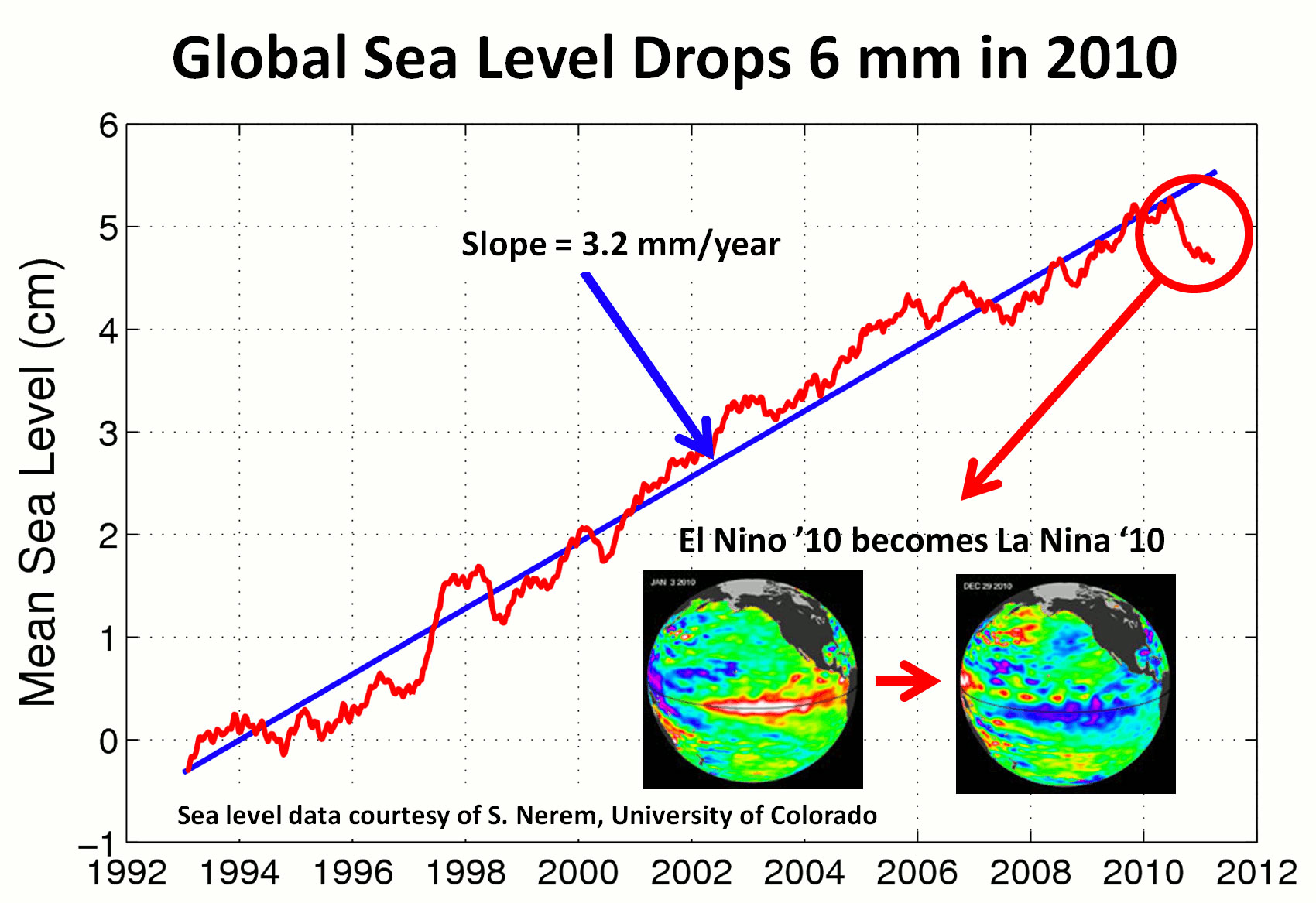
Figure 1 - sea level rise 1993-2011 from satellite altimetry. Image from NASA JPL
Short-term sea level fluctuations
Perhaps a poorly understood process, on climate blogs, is the large exchange of water between the ocean and land over short timescales (months/years), which is illustrated in the NASA JPL article. Tremendous volumes of water are evaporated from the world's oceans, and as the holding capacity of the atmosphere is small compared to the land and ocean, this evaporated water ultimately ends up back in the ocean, or on land in the form of either water, snow or ice.
Each year there are seasonal fluctuations in global sea level which are caused by water swapping back and forth between the land, atmosphere and ocean, and asymmetric (unbalanced) heating of both hemispheres. Because most of the world's land mass is in the Northern Hemisphere, a large amount of water is stored there in the winter in the form of ice, snow and water, and this results in an increase in land-based water storage. At the same time, the Southern Hemisphere is angled closer to the sun, and because it is mainly ocean, the sun heats a huge pool of water, creating a rise in sea level through thermal expansion. The end result of these two out-of-sync processes is the variation shown below, and which results in seasonal sea level fluctuations of 6-9mms.
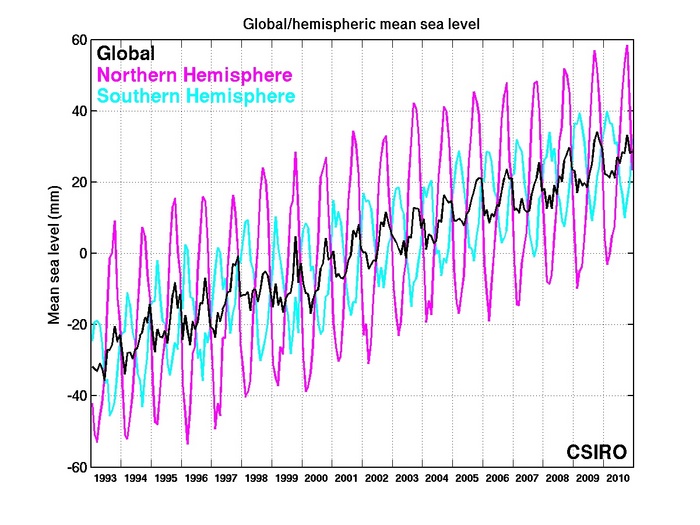
Figure 2 -Global and hemispheric-mean sea level from TOPEX/Poseidon and Jason-1. The two hemispheric signals partially cancel to produce a global signal with smaller amplitude. From www.cmar.csiro.au
The peak contribution of water mass to the global oceans generally occurs in September at the end of Northern Hemisphere summer as water, stored in snowpack, soils, lakes, rivers, soils and vegetation, is fed back into the sea. And the peak thermal component (ocean expansion from warming) occurs in April, at the end of the Southern Hemisphere summer - when the large expanse of Southern Ocean is exposed to greater solar heating. The annual global sea level peak matches the Northern Hemisphere run-off of water back into the oceans, which is the stronger of the two signals on a year-to-year basis. See Willis (2008) and Leuliette & Willis (2011) for an overview.
You will note the difference with figure 1, which has had the 'seasonal signal' removed to show the long-term trend. It should be obvious from both figure 1 & 2, that despite the large short-term fluctuations, these fluctuations are only temporary. Global sea levels continue to rise as the oceans warm and expand, and as more water mass is added to the oceans from the melting of land-based ice sheets and glaciers.
ENSO and global sea level
Massive water volumes are also exchanged between the land and ocean connected with the ENSO phases, La Nina and El Nino. During La Nina there is typically an increase of rain and snow falling over land, which corresponds with a fall in global sea level. With El Nino, the atmosphere warms, drying out much of the global land surface and shifting rainfall over the ocean. This brings about a rise in global sea level. See image below:
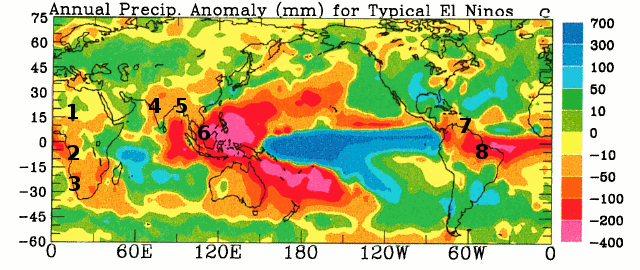
Figure 3 - annual precipitation anomalies (in mm) for typical El Nino. Note that yellow and light-green colors indicate statistically insignificant values. See Dai & Wigley (2000). Numbers represent the 8 largest tropical river basins 1) Niger, 2) Congo, 3) Okavango, 4) Indus, 5) Ganges, 6) Mekong, 7) Orinoco, 8) Amazon. See discussion below.
As mentioned in the Amazon drought posts, the Walker Circulation is shifted over the tropical Pacific during El Nino, causing the moisture evaporated from land and sea to fall back over the ocean, rather than over the Amazon. El Nino also causes serious drought over Australia, and drying of Southern Africa, India and South East Asia, so much of that land-based moisture ends up back in the ocean too.
Recent research, Llovel (2010), has found that tropical river basins, such as the Amazon, are the main contributor to the EL Nino/La Nina exchange of water mass with the ocean, and the Amazon is a major contributor to the seasonal variation too. For clarity, I've labelled figure 3 with the location of the 8 main tropical river basins which contribute to ENSO-based fluctuations in sea level. Note how all the tropical river basins tend to dry out during the El Nino phase. Now compare with the period March 2010- March 2011, which was in the grip of a particularly powerful La Nina:
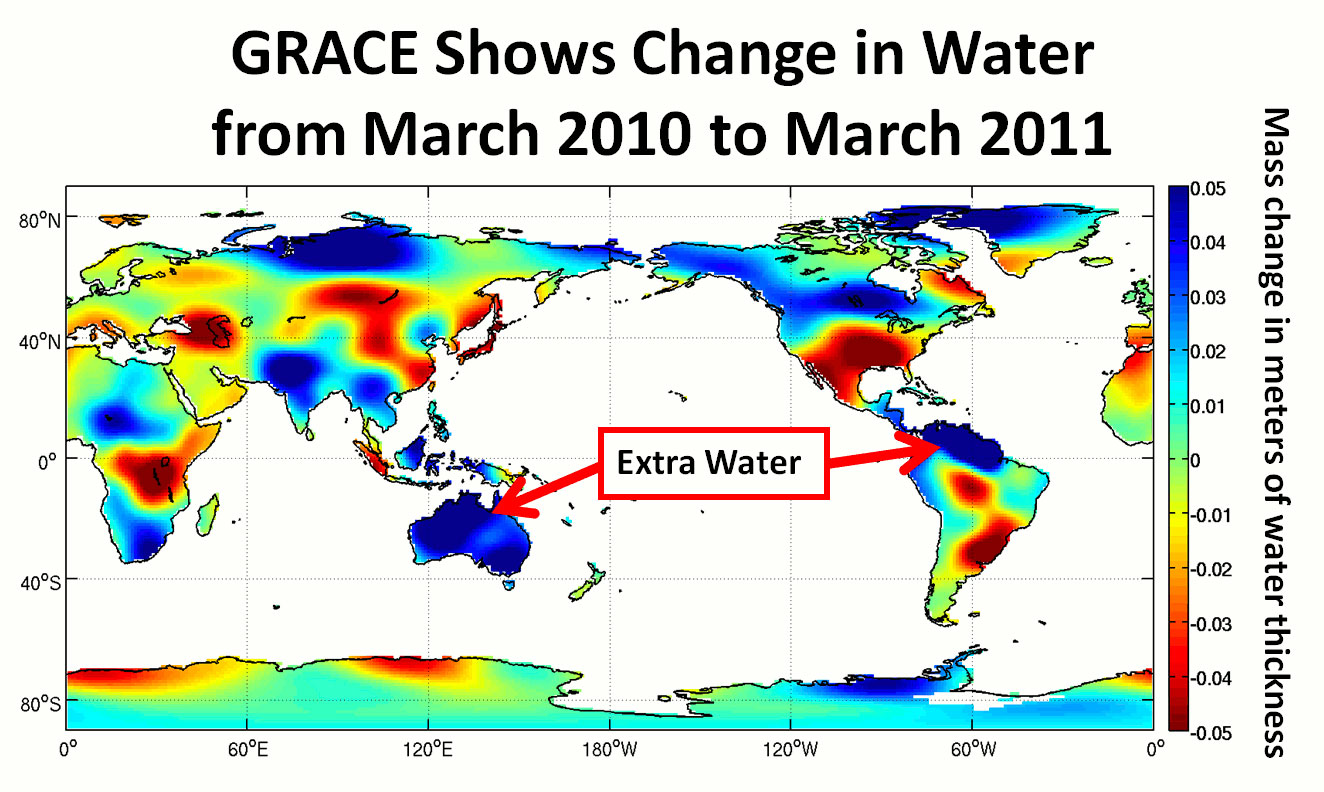
Figure 4 - change in land-based global water storage in the period March 2010-March 2011, as observed by GRACE gravity satellites. Image from NASA JPL.
All tropical river basins, apart from the Congo, have gained extra water throughout the latest La Nina. The huge increase in water mass over the Australian continent is rather hard to miss too. Not surprising given the enormous flooding there in the last year.
This regular fluctuation of sea level (falling during La Nina, and rising during El Nino) has been observed throughout the period of satellite-based sea level monitoring (1993 onwards). This can be seen in the de-trended (long-term trend removed to enable comparison) data in figure 5 below. Note that both the Multivariate ENSO Index (MEI, a measure of ENSO), and the related sea level change, fluctuate about zero. In other words ENSO does not contribute to long-term sea level.
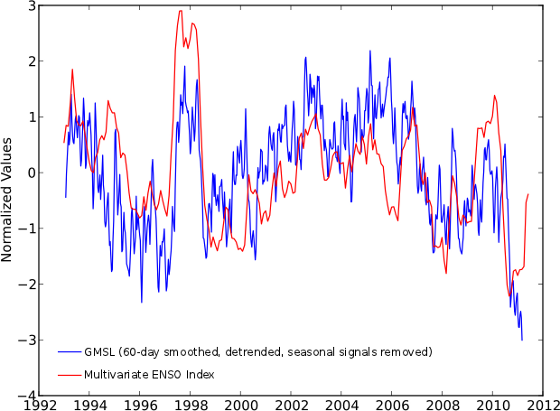
Figure 5 - To compare the global mean sea level to the MEI time series (a measure of ENSO), the mean, linear trend, and seasonal signals from the 60-day smoothed global mean sea level estimates have been removed, and each times series normalized by its standard deviation. The normalized values plotted above show a strong correlation between the global mean sea level and the MEI, with the global mean sea level often lagging changes in the MEI. Image from the University of Colorado sea level research group page.
Joining the dots
We regularly get "skeptics" posting here, pointing out the large drop in sea level during 2010, however it never seems to occur to them why sea level dropped. That water hasn't just magically disappeared, it's simply found a new temporary home on land, as the residents of Vermont in the USA have sadly just experienced. But it is only temporary, eventually all that water held in lakes, wetlands, rivers, soils and vegetation will find its way back into the ocean, and sea level will rise again. Long-term, expect the sea to continue rising as the oceans warm and melting glaciers and ice sheets constantly add more water to the oceans, but don't be surprised if there's a large pothole, or speed bump, along the way.
This is the intermediate rebuttal of Sea level fell in 2010































 Arguments
Arguments































[DB] Color scale added from the JPL website.